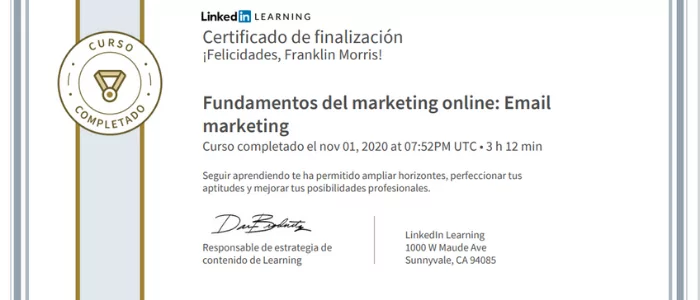The Best Way to Learn Spanish: My Journey to Fluency
Around 2016 and 2017, in the midst of me doing my Duolingo Spanish course, I was constantly searching the web to find out the best way to learn Spanish.
I watched various language learning YouTube videos, I read some blog posts, and I would read posts in the Duolingo forum. Eventually, I settled upon a method that has enabled me to watch native level YouTube videos in Spanish on a variety of subjects, take some Spanish LinkedIn Learning courses, read native level Spanish books, go to an all Spanish environment, which in my case was a Spanish church, and etc.
Duolingo helped me start my Spanish journey, but its course isn’t designed to get you to an advanced level in Spanish.
Duolingo is what I used to help start my Spanish journey. It did help me learn more Spanish words, etc. than I had known before. Their first Spanish lesson was easy enough that I was excited to continue learning Spanish. I was connected to a community of language enthusiasts. In addition, Duolingo was free.
On the flip side, back in the day, Duolingo had a fluency meter, and I literally thought that my fluency in Spanish was directly related to that meter. For a time, I thought that when I finished my Duolingo Spanish course, I would actually be fluent in Spanish. I still wanted to be sure I was learning Spanish in the best way, so I took notice sometimes of what people wrote when they completed a Duolingo Spanish course. Some people said that they completed the Duolingo course, but they still were having problems watching Spanish programs outside of Duolingo.
I’ve come to realize based on Duolingo’s April 2019 blog post , that no matter how much time you spend on a Duolingo Spanish course, you’re not going to reach higher than a B1 level (a low intermediate level) if you only use the Duolingo course material. Based on that article, their Spanish course isn’t designed for people to go above a B1 level. If you want to get to an upper intermediate or higher level, you’re going to need to continue learning Spanish outside of Duolingo. Some people do a Duolingo course for 1,000 days or more, but to me, that’s like riding a bicycle with training wheels for 1,000 days. Eventually, in order to ride a bicycle properly, the training wheels have to come off.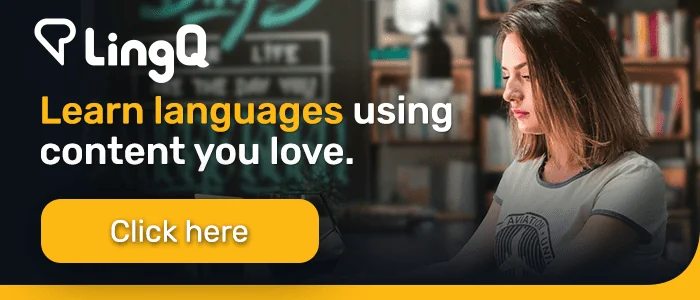
Reading and listening to Spanish: A more effective way to learn Spanish?
Before I finished my Duolingo Spanish course in April 2017, I learned that some people had been learning a foreign language via reading and listening.
It was a simple approach, but it was something that made so much more sense to me because as babies, we spend a lot of time absorbing a language before we speak it. Listening prepares us for speaking. As I was going through my Duolingo Spanish course, I thought I was going to get to level 25. I equated being a serious language learner to getting to level 25 in Duolingo, but as I thought more about the possibilities of reading and listening to Spanish as a language learning strategy, I stopped using Duolingo to learn Spanish shortly after I finished my course.
I abandoned my desire to be a master of Duolingo, and I focused more on being able to use Spanish in a real world context.
How I read my first Spanish book
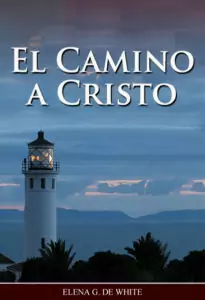
The first Spanish book I started to read was El Camino a Cristo.
I wanted to start off my Spanish reading journey by reading a Philippians 4:8 native level book for Spanish speaking adults. That is an atypical selection for a beginner to read, but I figured that my mind would adapt to whatever it read, so I wanted to be ambitious with what I was reading.
It was a struggle reading my first Spanish book. I tried to read a paper version of El Camino a Cristo, and in almost every sentence I had to look up words. I first tried using a paper dictionary, but I soon realized that was too slow and ineffective. Therefore, I used Google Translate. I had a digital version of El Camino a Cristo on my phone, and then I used Google Translate to look up the words or phrases I didn’t know. Afterwards, I would write the words I didn’t know inside of the book.
It was a cumbersome, tedious process. However, after having a goal of reading 1 page a day, 5 days a week, I actually finished reading El Camino a Cristo in April 2018.
Reading Spanish increased my listening comprehension
After I read chapter 2 of El Camino a Cristo, I listened to part of the audiobook version of the chapter for the first time while I was driving to work. I understood around 40% of what I listened to. Around that time, I usually understood around 1-15% of what I listened to in Spanish, so this was a big deal. I started to see for myself that reading actually helped increase my listening comprehension.
In 2018, I started to watch native level Spanish YouTube videos with Spanish subtitles. Because I had started reading in Spanish, I could read some of the Spanish subtitles. Therefore, I could more easily match the sounds in the YouTube videos to the words I was able to read. That combination of reading and listening strengthened my comprehension to the point that I now rarely watch Spanish YouTube videos with any subtitles.
LingQ has helped me read Spanish books more effectively
Around 2017, I “met” Connie Warner in a Facebook language learning group. She now is my friend and someone I call my language motivational partner.
The first post I saw from Connie in that Facebook group was about how she was reading in Portuguese. Because of our mutual interest in reading and listening as a strategy to learn a language, we became friends. When I met Connie, she was reading her 10th book or so in Portuguese. (I should add that in 2019, Connie grew in her Portuguese self study to the point that she did simultaneous translation from Portuguese to English at a Brazilian church in the US).
From time to time as I told Connie about my experience with reading El Camino a Cristo, she would mention to me how she was using LingQ. She would sometimes share with me some of her LingQ progress reports, but I wasn’t really interested. I was following my own way of reading.
The second Spanish book I read was Palabras de Vida del Gran Maestro. I again started to read it using both a paper and digital version like I had done with El Camino a Cristo. However, I finally listened to Connie, and I decided to try out using LingQ. I uploaded Palabras de Vida del Gran Maestro to LingQ (read this post to find out how to import books into LingQ), and I realized LingQ would actually help me read faster. If I could read books faster, then it would help increase my comprehension faster, both in listening and reading, as well.
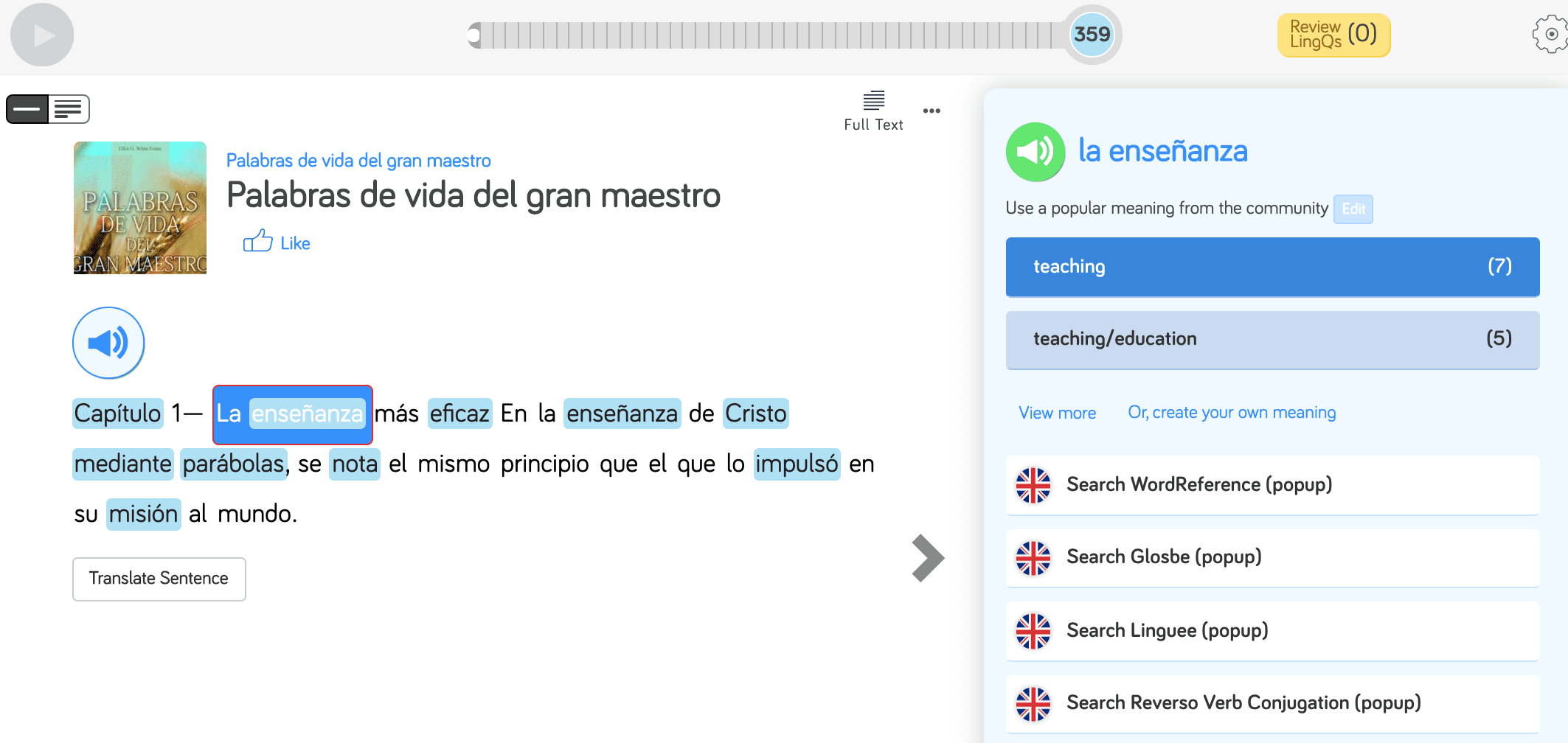
To me, LingQ’s app is a very effective tool for reading Spanish books. If I don’t know the meaning of a word, I can just click on it, and I can get the English translation. I’m thankful that I’m first challenged to read the Spanish words without any translation, so I constantly get contact with real world Spanish.
This app has allowed me to comprehend native level Spanish books. I’ve also valued the fact that I can import PDF books of my choosing into LingQ to read. Check out the video below for a quick tutorial. LingQ has a website version, too, that I’ve used, but I sometimes like to read in Spanish using my phone instead of my laptop, so the app is very useful.
One other LingQ feature I like is that LingQ counts the amount of words I’ve read. This is helpful, especially when I want to track my progress. I’ve read over 1 million Spanish words with LingQ!
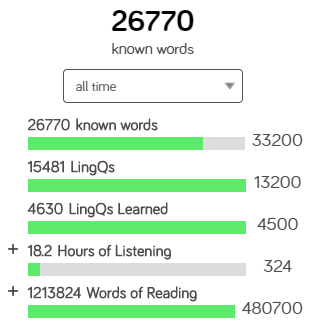
Reading and listening to Spanish has helped me use Spanish in a real world context
Among other things, I regularly go to Spanish Christian Zoom meetings with native Spanish speakers from Costa Rica, and many times I understand up to around 90% or more of what is spoken in the Spanish Zoom meetings.
Honestly, I do not sound like a native Spanish speaker, and I make plenty of mistakes, but I talk with these Costa Ricans in Spanish. Reading and listening to Spanish has helped me not have to dominate the conversation because I’m continuing to grow in my capacity to understand what other people are saying.
I challenge you to read at least 1 million words in Spanish!
If you’re seeking to use Spanish in a real world context instead of spending years trying to master a beginner Spanish program, you should consider using LingQ. It’s not enough to just have LingQ; it’s important to use it to get the benefits of reading. I challenge you to read at least 1 million words in Spanish with LingQ. This will help you with also being able to listen and eventually speak Spanish as well.
How long does it take to learn Spanish? Check out polyglot and LingQ cofounder Steve Kaufmann’s blog post to learn about the 5 factors that influence this!
***
Author: Franklin Morris II
Franklin has a language learning YouTube channel called First1000Hours. He seeks to inspire and motivate people to complete their first 1,000 hours of their language learning marathon with an out of the box mentality.

